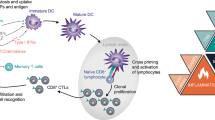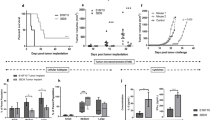Abstract
We examined the feasibility of using tumor apoptosis at accessible sites to enhance antimelanoma immune responses in a model of spontaneous canine melanoma. We show that priming peripheral blood mononuclear cells with apoptotic melanoma cells significantly enhanced autologous and allogeneic lymphokine-activated killing of tumor cells. Since various pathways required for intrinsic apoptosis are often inactivated in melanoma, we used Fas ligand (FasL) overexpression to promote extrinsic apoptosis. FasL induced apoptosis in five of six cell lines. Each of the susceptible lines, but not the resistant one, expressed Fas mRNA. In addition, direct intratumoral administration of FasL DNA to tumor-bearing dogs was safe, with no adverse events reported over 7 days of observation. A reduction of tumor burden was seen in three of five dogs treated. The reduction of tumor volume was correlated with Fas expression by the tumors, although one dog with a Fas-negative tumor survived for 82 weeks after treatment. Our data show that overexpression of FasL is suitable to promote apoptosis of Fas+ melanomas, and support the notion that priming immune responder cells with apoptotic tumor cells may enhance antitumor responses. The results also suggest that intratumoral administration of FasL offers a safe route for therapeutic gene delivery.
This is a preview of subscription content, access via your institution
Access options
Subscribe to this journal
Receive 12 print issues and online access
$259.00 per year
only $21.58 per issue
Buy this article
- Purchase on Springer Link
- Instant access to full article PDF
Prices may be subject to local taxes which are calculated during checkout





Similar content being viewed by others
References
Modiano JF, Ritt MG, Wojcieszyn J . The molecular basis of canine melanoma: pathogenesis and trends in diagnosis and therapy. J Vet Intern Med. 1999;13:163–174.
Dow SW, Elmslie RE, Willson AP, et al. In vivo tumor transfection with superantigen plus cytokine genes induces tumor regression and prolongs survival in dogs with malignant melanoma. J Clin Invest. 1998;101:2406–2414.
Houghton AN, Gold JS, Blachere NE . Immunity against cancer: lessons learned from melanoma. Curr Opin Immunol. 2001;13:134–140.
Kim CJ, Dessureault S, Gabrilovich D, et al. Immunotherapy for melanoma. Cancer Control. 2002;9:22–30.
Quintin-Colonna F, Devauchelle P, Fradelizi D, et al. Gene therapy of spontaneous canine melanoma and feline fibrosarcoma by intratumoral administration of histoincompatible cells expressing human interleukin-2. Gene Therapy. 1996;3:1104–1112.
Albert ML, Sauter B, BhardwaJ N . Dendritic cells acquire antigen from apoptotic cells and induce class I-restricted CTLs. Nature. 1998;392:86–89.
Bellone M, Iezzi G, Rovere P, et al. Processing of engulfed apoptotic bodies yields T cell epitopes. J Immunol. 1997;159:5391–5399.
Henry F, Boisteau O, Bretaudeau L, et al. Antigen-presenting cells that phagocytose apoptotic tumor-derived cells are potent tumor vaccines. Cancer Res. 1999;59:3329–3332.
Koenig A, Bianco SR, Fosmire S, et al. Expression and significance of p53, rb, p21/waf-1, p16/ink-4a, and PTEN tumor suppressors in canine melanoma. Vet Pathol. 2002;39:458–472.
Simon AK, Gallimore A, Jones E, et al. Fas ligand breaks tolerance to self-antigens and induces tumor immunity mediated by antibodies. Cancer Cell. 2002;2:315–322.
Gregory MS, Repp AC, Holhbaum AM, et al. Membrane Fas ligand activates innate immunity and terminates ocular immune privilege. J Immunol. 2002;169:2727–2735.
Shimizu M, Fontana A, Takeda Y, et al. Fas/Apo-1 (CD95)-mediated apoptosis of neutrophils with Fas ligand (CD95L)-expressing tumors is crucial for induction of inflammation by neutrophilic polymorphonuclear leukocytes associated with antitumor immunity. Cell Immunol. 2001;207:41–48.
Shudo K, Kinoshita K, Imamura R, et al. The membrane-bound but not the soluble form of human Fas ligand is responsible for its inflammatory activity. Eur J Immunol. 2001;31:2504–2511.
Wajant H . The Fas signaling pathway: more than a paradigm. Science. 2002;296:1635–1636.
Krammer PH . CD95's deadly mission in the immune system. Nature. 2000;407:789–795.
Arai H, Gordon D, Nabel EG, et al. Gene transfer of Fas ligand induces tumor regression in vivo. Proc Natl Acad Sci USA. 1997;94:13862–13867.
Seino K, Kayagaki N, Okumura K, et al. Antitumor effect of locally produced CD95 ligand. Nat Med. 1997;3:165–170.
Behrens CK, Igney FH, Arnold B, et al. CD95 ligand-expressing tumors are rejected in anti-tumor TCR transgenic perforin knockout mice. J Immunol. 2001;166:3240–3247.
Bergmann-Leitner ES, Abrams SI . Positive and negative consequences of soluble Fas ligand produced by an antigen-specific CD4(+) T cell response in human carcinoma immune interactions. Cell Immunol. 2001;209:49–62.
Chio CC, Wang YS, Chen YL, et al. Down-regulation of Fas-L in glioma cells by ribozyme reduces cell apoptosis, tumour-infiltrating cells, and liver damage but accelerates tumour formation in nude mice. Br J Cancer. 2001;85:1185–1192.
Hedlund TE, Meech SJ, Srikanth S, et al. Adenovirus-mediated expression of Fas ligand induces apoptosis of human prostate cancer cells. Cell Death Differ. 1999;6:175–182.
Koenig A, Wojcieszyn J, Weeks BR, et al. Expression of S100a, vimentin, NSE, and Melan A/MART-1 in seven canine melanoma cell lines and twenty-nine retrospective cases of canine melanoma. Vet Pathol. 2001;38:427–435.
Ritt MG, Wojcieszyn J, Modiano JF . Functional loss of p21/Waf-1 in a case of benign canine multicentric melanoma. Vet Pathol. 1998;35:94–101.
Helfand SC, Soergel SA, Modiano JF, et al. Induction of lymphokine-activated killer (LAK) activity in canine lymphocytes with low dose human recombinant interleukin-2 in vitro. Cancer Biother. 1994;9:237–244.
Modiano JF, Ritt MG, Wojcieszyn J, et al. Growth arrest of melanoma cells is differentially regulated by contact inhibition and serum deprivation. DNA Cell Biol. 1999;18:357–367.
Ritt MG, Mayor J, Wojcieszyn J, et al. Sustained nuclear localization of p21/WAF-1 upon growth arrest induced by contact inhibition. Cancer Lett. 2000;158:73–84.
Nagata S, Golstein P . The Fas death factor. Science. 1995;267:1449–1456.
Bertram JS, Janik P . Establishment of a cloned line of Lewis Lung Carcinoma cells adapted to cell culture. Cancer Lett. 1980;11:63–73.
Harvey HJ, MacEwen EG, Braun D, et al. Prognostic criteria for dogs with oral melanoma. J Am Vet Med Assoc. 1981;178:580–582.
Hahn KA, DeNicola DB, Richardson RC, et al. Canine oral malignant melanoma: prognostic utility of an alternative staging system. J Small Anim Pract. 1994;35:251–256.
MacEwen EG, Patnaik AK, Harvey HJ, et al. Canine oral melanoma: comparison of surgery versus surgery plus Corynebacterium parvum. Cancer Invest. 1986;4:397–402.
O'Day SJ, Kim CJ, Reintgen DS . Metastatic melanoma: chemotherapy to biochemotherapy. Cancer Control. 2002;9:31–38.
Bateman KE, Catton PA, Pennock PW, et al. 0-7-21 radiation therapy for the treatment of canine oral melanoma. J Vet Intern Med. 1994;8:267–272.
Ramos-Vara JA, Beissenherz ME, Miller MA, et al. Retrospective study of 338 canine oral melanomas with clinical, histologic, and immunohistochemical review of 129 cases. Vet Pathol. 2000;37:597–608.
Hofbauer GF, Kamarashev J, Geertsen R, et al. Melan A/MART-1 immunoreactivity in formalin-fixed paraffin-embedded primary and metastatic melanoma: frequency and distribution. Melanoma Res. 1998;8:337–343.
Moore AS, Theilen GH, Newell AD, et al. Preclinical study of sequential tumor necrosis factor and interleukin 2 in the treatment of spontaneous canine neoplasms. Cancer Res. 1991;51:233–238.
Hogge GS, Burkholder JK, Culp J, et al. Development of human granulocyte–macrophage colony-stimulating factor-transfected tumor cell vaccines for the treatment of spontaneous canine cancer. Hum Gene Ther. 1998;9:1851–1861.
Hogge GS, Burkholder JK, Culp J, et al. Preclinical development of human granulocyte–macrophage colony-stimulating factor-transfected melanoma cell vaccine using established canine cell lines and normal dogs. Cancer Gene Ther. 1999;6:26–36.
Barker RN, Erwig LP, Hill KS, et al. Antigen presentation by macrophages is enhanced by the uptake of necrotic, but not apoptotic, cells. Clin Exp Immunol. 2002;127:220–225.
Reddy SM, Hsiao KH, Abernethy VE, et al. Phagocytosis of apoptotic cells by macrophages induces novel signaling events leading to cytokine-independent survival and inhibition of proliferation: activation of Akt and inhibition of extracellular signal- regulated kinases 1 and 2. J Immunol. 2002;169:702–713.
Savill J, Fadok V . Corpse clearance defines the meaning of cell death. Nature. 2000;407:784–788.
Helfand SC, Soergel SA, Donner RL, et al. Potential to involve multiple effector cells with human recombinant interleukin-2 and antiganglioside monoclonal antibodies in a canine malignant melanoma immunotherapy model. J Immunother. 1994;16:188–197.
Helfand SC, Dickerson EB, Munson KL, et al. GD3 ganglioside antibody augments tumoricidal capacity of canine blood mononuclear cells by induction of interleukin 12. Cancer Res. 1999;59:3119–3127.
Acknowledgements
We thank the technical and nursing staffs of the Animal Cancer Center of Colorado State University and Animal Hospital Center for assistance with care and handling of dogs in this study and Drs Erin Dickerson and Valerie Fadok for critical review of the manuscript. This work was supported in part by Grant 1626 from the AKC Canine Health Foundation and Grant 98CA-36 from the Morris Animal Foundation. SRB was supported in part by a fellowship from the University of Colorado Cancer Center.
Author information
Authors and Affiliations
Corresponding author
Rights and permissions
About this article
Cite this article
Bianco, S., Sun, J., Fosmire, S. et al. Enhancing antimelanoma immune responses through apoptosis. Cancer Gene Ther 10, 726–736 (2003). https://doi.org/10.1038/sj.cgt.7700625
Received:
Published:
Issue Date:
DOI: https://doi.org/10.1038/sj.cgt.7700625
Keywords
This article is cited by
-
Combination of cytokine-enhanced vaccine and chemo-gene therapy as surgery adjuvant treatments for spontaneous canine melanoma
Gene Therapy (2019)
-
Comparative cytogenetic characterization of primary canine melanocytic lesions using array CGH and fluorescence in situ hybridization
Chromosome Research (2015)
-
IL-12 based gene therapy in veterinary medicine
Journal of Translational Medicine (2012)
-
Cytokine-enhanced vaccine and suicide gene therapy as surgery adjuvant treatments for spontaneous canine melanoma: 9 years of follow-up
Cancer Gene Therapy (2012)
-
Inflammation, Apoptosis, and Necrosis Induced by Neoadjuvant Fas Ligand Gene Therapy Improves Survival of Dogs With Spontaneous Bone Cancer
Molecular Therapy (2012)



